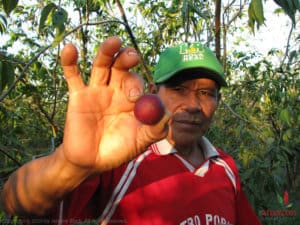
In Peru, “camu camu” is the local colloquial term for the Myrciaria dubia, a shrub native to the western region of the Amazon. It thrives in floodplain zones, where it remains submerged underwater for several months at a time. The species was first described by famed botanist, Rogers McVaugh, in 1958. Below, we discuss camu camu biology, specifically regarding its appearance.
Identification & Appearance
This shrub that can reach three to eight meters in height.1 The trunk is smooth, light brown to purple in color, and can measure up to fifteen centimeters in diameter. During dry periods, the bark peels off naturally. It is deeply rooted, and these roots contain many hairs for absorbing nutrients and water.2
Leaves are opposed, with two leaves springing from the stem or trunk at the same node. They are attached by a vascular petiole (of three to six millimeters long and one or two millimeters wide) and are both elliptical and lanceolate in shape. They measure between three and ten centimeters in length and 1.5-4.5 centimeters wide.3
Camu Camu Flower
This species features axial flowering, growing on both the trunk and on adult branches.4 Four hermaphrodite flowers emerge directly from the stem or trunk and are arranged in two pairs. The flowers are small (about one centimeter wide) and feature round bracts that are covered in many microscopic hairs. The petals are small, white, and carry a sweet fragrance. Each flower contains roughly 125 stamens that are six to ten millimeters in length.5
Camu Camu Fruit
The fruits are round, globular, and about the size of a large grape, measuring between one and three centimeters in diameter. It has a thin, lustrous skin that begins with a bright green color and transitions to a deep wine color as it matures. Inside is a juicy, highly acidic pulp that is pink in color. Each fruit contains one to four seeds per fruit, but three is most common. The seeds are larger in size, yellow, flat, and kidney-shaped.6
Alves, Ricardo Elesbao, et al. “Camu-Camu (Myrciaria Dubia Mc Vaugh): A Rich Natural Source of Vitamin C .” Proceedings of the Interamerican Society for Tropical Horticulture, vol. 46, 2002, pp. 11–13., http://www.ceinfo.cnpat.embrapa.br/arquivos/artigo_1581.pdf. ↩
Peters, Charles M., and A. Vasquez. “Estudios Ecológicos De Camu-Camu (Myrciaria dubia). I. Producción De Frutos En Poblaciones Naturales.” Acta Amazonica, vol. 17, no. 0, 1987, pp. 161–188., doi:10.1590/1809-43921987171174. ↩
Peters, Charles M., and A. Vasquez. “Estudios Ecológicos De Camu-Camu (Myrciaria dubia). I. Producción De Frutos En Poblaciones Naturales.” Acta Amazonica, vol. 17, no. 0, 1987, pp. 161–188., doi:10.1590/1809-43921987171174. ↩
Peters, Charles M., and A. Vasquez. “Estudios Ecológicos De Camu-Camu (Myrciaria dubia). I. Producción De Frutos En Poblaciones Naturales.” Acta Amazonica, vol. 17, no. 0, 1987, pp. 161–188., doi:10.1590/1809-43921987171174. ↩
Peters, Charles M., and A. Vasquez. “Estudios Ecológicos De Camu-Camu (Myrciaria dubia). I. Producción De Frutos En Poblaciones Naturales.” Acta Amazonica, vol. 17, no. 0, 1987, pp. 161–188., doi:10.1590/1809-43921987171174. ↩
Peters, Charles M., and A. Vasquez. “Estudios Ecológicos De Camu-Camu (Myrciaria dubia). I. Producción De Frutos En Poblaciones Naturales.” Acta Amazonica, vol. 17, no. 0, 1987, pp. 161–188., doi:10.1590/1809-43921987171174. ↩
